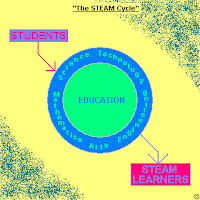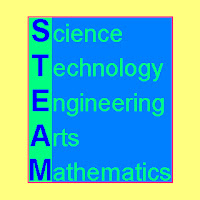A Vision of STEAM Education
Author: Manuel R. CortezRodas
We now present a view of STEAM Education as envisioned at MRCR Education. First, we take a look at the STEAM Educational Cycle, then we demonstrate how to link the strands of STEAM in a lesson plan.
The STEAM Education Cycle
 The STEAM education cycle begins when the student is introduced to the five strands of STEAM. Students who are educated in STEAM can become STEAM learners. This approach will challenge students to cross-reference what they are learning. It should allow students to connect and apply knowledge across the five unique strands in a way that expands their level of thinking. Understanding a scientific concept like the water cycle is not enough. The student should be able to relate the water cycle to tools in technology we have engineered like thermometers, barometers, and hydrometers which allow us to collect numeric data using a mathematical approach. This in turn will help us to better understand a scientific idea, while at the same time being able to visualize this cycle in a multitude of terrains as it takes place throughout the world.
The STEAM education cycle begins when the student is introduced to the five strands of STEAM. Students who are educated in STEAM can become STEAM learners. This approach will challenge students to cross-reference what they are learning. It should allow students to connect and apply knowledge across the five unique strands in a way that expands their level of thinking. Understanding a scientific concept like the water cycle is not enough. The student should be able to relate the water cycle to tools in technology we have engineered like thermometers, barometers, and hydrometers which allow us to collect numeric data using a mathematical approach. This in turn will help us to better understand a scientific idea, while at the same time being able to visualize this cycle in a multitude of terrains as it takes place throughout the world.
Linking STEAM in a Lesson
Let us take a look at how a theme can be used to develop a STEAM lesson that links all five strands. In the sample lesson, we see that the theme that has been selected is "Hammers". in the strand of science, the connection to the theme is what happens when hammers strike? The scientific concepts that are associated with hammers include force, pressure, sound, vibration, etc. Under technology, the development of hammers through time is the connection, as we look at the needs for each era. The use of hammers in engineering has us turn our attention to railroads, homes, and tents; while in the arts we can search and find paintings like "Thor's Battle with the Ettins", not to mention that hammers have also been used by sculptures to create statues. The strand of mathematics provides for us a way to compare and evaluate how the material of the hammer, at different weights, produces different results, which in itself completes the circle by linking this to science.
This is but one view of how STEAM can be developed into a lesson for the student to expand one theme across five strands. It can be done with a variety of themes, and students can be allowed to generate their own themes and lessons by following the sample plan that has been presented here.
Copyright 2012. MRCR Educational Consulting Firm. All Rights Reserved.



